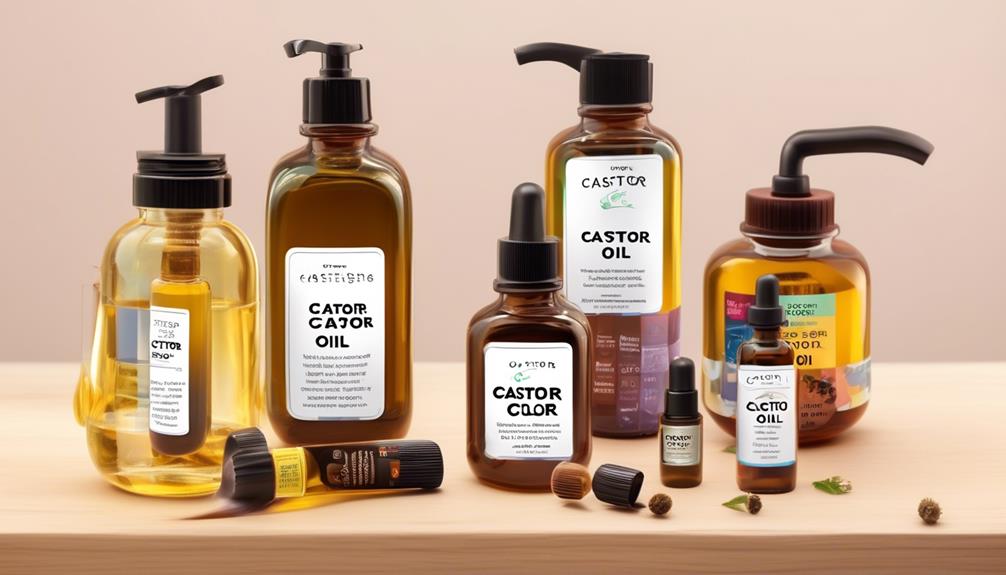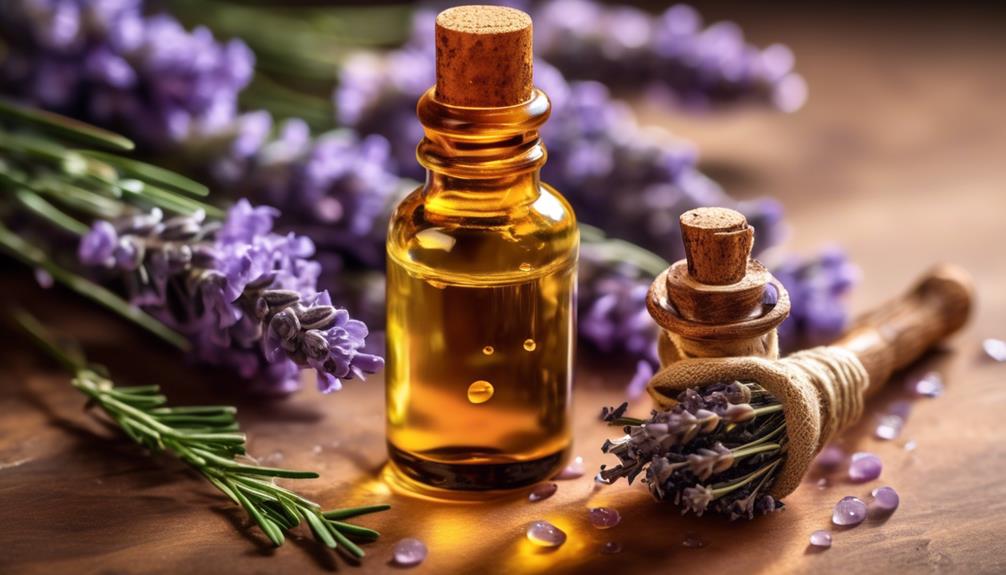How Do You Mix Castor Oil for Hair Growth?
The quest for healthy and luscious hair is a journey many of us embark on, seeking natural remedies to promote growth and vitality. Castor oil, with its renowned benefits, has become a popular choice in hair care routines.
But how exactly do you mix castor oil for hair growth? The answer lies in understanding the right type of castor oil, the role of carrier oils, the ideal ratios, and the addition of essential oils.
The process involves a careful combination of ingredients, followed by a specific application technique.
So, if you’re curious to unlock the secrets of incorporating castor oil into your hair care regimen, join me as we explore the art of mixing castor oil for optimal hair growth results.
Key Takeaways
- Choose 100% pure castor oil without synthetic substances for optimal results
- Use cold-pressed castor oil to benefit from its high concentration of ricinoleic acid
- Consider using pharmaceutical grade castor oil for its quality
- Understand the mixing ratios and methods to achieve the desired outcome for hair growth
Choosing the Right Type of Castor Oil

When selecting the appropriate castor oil for hair growth, it is crucial to consider various factors such as purity, extraction method, and grade, in order to ensure optimal results.
Purity refers to the absence of impurities or additives in the castor oil, which can affect its efficacy. It is recommended to choose a castor oil that is 100% pure and free from any synthetic substances.
The extraction method of the castor oil also plays a significant role in its quality. Cold-pressed castor oil is considered the best option as it is extracted without the use of heat or chemicals, preserving its natural nutrients and beneficial properties. This method ensures that the oil retains its high concentration of ricinoleic acid, which is known for its hair growth promoting properties.
Moreover, considering the grade of castor oil is essential. There are different grades of castor oil available, such as pharmaceutical grade, cosmetic grade, and industrial grade. It is recommended to opt for pharmaceutical grade castor oil as it is the highest quality and is free from impurities.
Understanding Carrier Oils for Mixing
When it comes to mixing castor oil for hair growth, understanding carrier oils is essential.
Carrier oils are used to dilute the potency of essential oils and help them better penetrate the scalp and hair follicles.
There are various types of carrier oils to choose from, each with its own unique benefits and properties.
Understanding the different types of carrier oils, their benefits, and the appropriate mixing ratios and methods is crucial for achieving optimal results in promoting hair growth.
Types of Carrier Oils
To achieve optimal results when mixing castor oil for hair growth, it is crucial to have a comprehensive understanding of the various types of carrier oils used in the process. Carrier oils are used to dilute the potency of castor oil and increase its effectiveness when applied to the scalp. Different carrier oils offer unique benefits and properties that can enhance hair growth and overall hair health. Below is a table outlining some commonly used carrier oils for mixing with castor oil:
| Carrier Oil | Properties | Benefits |
|---|---|---|
| Coconut oil | Moisturizing, antibacterial | Nourishes hair, prevents breakage |
| Jojoba oil | Lightweight, non-greasy | Conditions hair, promotes hair growth |
| Olive oil | Rich in vitamins and antioxidants | Strengthens hair, reduces frizz |
| Argan oil | Hydrating, high in fatty acids | Improves hair elasticity, adds shine |
| Almond oil | Nutrient-rich, promotes hair thickness | Softens hair, reduces hair loss |
Benefits of Carrier Oils
Understanding the benefits of carrier oils is essential in order to maximize the effectiveness of mixing castor oil for hair growth and maintain overall hair health.
Carrier oils, also known as base oils, are used to dilute essential oils and act as a vehicle to deliver them to the scalp and hair follicles. These oils have their own unique properties that can enhance hair growth and provide nourishment to the hair and scalp.
One of the key benefits of carrier oils is their ability to moisturize and hydrate the hair. They form a protective barrier that locks in moisture and prevents moisture loss, which can lead to dryness and breakage. Additionally, carrier oils help to improve blood circulation to the scalp, promoting hair growth and preventing hair loss.
Carrier oils also contain essential fatty acids, such as omega-3 and omega-6, which are vital for hair health. These fatty acids nourish and strengthen the hair shaft, making it less prone to damage and breakage. Furthermore, carrier oils are rich in vitamins, antioxidants, and minerals that provide the necessary nutrients for healthy hair growth.
Mixing Ratios and Methods
In order to achieve optimal results when mixing castor oil for hair growth, it is crucial to have a thorough understanding of carrier oils and their specific ratios and methods of mixing.
Carrier oils serve as a base for diluting castor oil and enhancing its effectiveness by delivering it to the scalp and hair follicles. The ratio of carrier oil to castor oil varies depending on the desired outcome and hair type. For individuals with oily hair, a higher ratio of carrier oil to castor oil, such as 3:1 or 4:1, is recommended. Conversely, those with dry or damaged hair may benefit from a lower ratio, such as 1:1 or 2:1.
It is essential to mix the oils thoroughly to ensure even distribution and maximize their nourishing properties. To do so, simply combine the oils in a clean container and mix well using a spoon or a glass rod. The resulting mixture can then be applied to the scalp and hair, gently massaging it in for optimal absorption.
Determining the Ideal Castor Oil to Carrier Oil Ratio
An essential step in achieving optimal hair growth results with castor oil is determining the ideal ratio of castor oil to carrier oil. This ratio is crucial as it ensures the proper dilution of castor oil, allowing it to effectively penetrate the scalp and hair follicles. To help you find the perfect balance, consider the following table which outlines different ratios and their recommended uses:
| Ratio (Castor Oil : Carrier Oil) | Recommended Use |
|---|---|
| 1 : 1 | Daily conditioning and maintenance |
| 1 : 2 | Weekly deep conditioning |
| 1 : 3 | Intensive treatment for dry or damaged hair |
| 1 : 4 | Scalp massage for increased circulation |
| 1 : 5 | Pre-shampoo treatment to stimulate hair growth |
Adding Essential Oils for Enhanced Benefits

To enhance the benefits of castor oil for hair growth, incorporating essential oils into your mixture can provide additional nourishment and promote overall scalp health. Essential oils are highly concentrated plant extracts that possess various properties beneficial for hair health. When combined with castor oil, these essential oils can work synergistically to address specific hair concerns and stimulate hair growth.
One essential oil that pairs well with castor oil is lavender oil. Lavender oil has been shown to promote hair growth by increasing the number of hair follicles and improving blood circulation to the scalp. Its soothing properties can also alleviate scalp irritation and inflammation, creating an optimal environment for healthy hair growth.
Another essential oil to consider is rosemary oil. Rosemary oil has been used for centuries to improve hair thickness and stimulate hair growth. It helps to increase cellular metabolism, which in turn promotes hair growth. Additionally, rosemary oil has antimicrobial properties that can help maintain a clean and healthy scalp, reducing the risk of scalp infections that could hinder hair growth.
When adding essential oils to your castor oil mixture, it is important to dilute them properly to avoid skin irritation. A general guideline is to add around 5-10 drops of essential oil for every ounce of castor oil. However, this ratio can be adjusted based on personal preference and hair type.
Heating and Mixing the Oils Together
To effectively combine the benefits of castor oil and essential oils for hair growth, the next step is to carefully heat and mix the oils together. Heating the oils helps to enhance their properties and allows for better absorption into the scalp and hair follicles. When heated, the oils become more viscous and easier to blend.
To heat and mix the oils, follow these steps:
- Measure the desired amounts of castor oil and essential oils into a heat-resistant container. Use a ratio of 1 part castor oil to 3 parts carrier oil, such as coconut or olive oil.
- Place the container in a double boiler or a heat-safe bowl over a pot of simmering water. This indirect heat method ensures that the oils are heated gently and prevents them from overheating or burning.
- Stir the oils continuously with a spoon or whisk until they are well combined and heated through. This process usually takes around 5-10 minutes.
- Once the oils are heated and blended, remove the container from the heat and let it cool slightly before using. Be cautious not to use the oils while they are still hot, as they can cause burns to the scalp.
Applying the Castor Oil Mixture to Your Hair

To effectively apply the castor oil mixture to your hair, it is important to follow a precise and scientific approach. Here are the steps you need to take:
- Section your hair: Divide your hair into manageable sections using clips or hair ties. This will ensure that the castor oil mixture is evenly distributed throughout your hair.
- Apply the mixture: Take a small amount of the castor oil mixture and apply it to the roots of each section. Use your fingertips to massage the oil into your scalp, stimulating blood flow and promoting hair growth.
- Work it through: Once you have applied the oil to your roots, gently work it through the length of your hair. Use a wide-toothed comb to distribute the oil evenly, ensuring that every strand is coated.
Frequency and Duration of Use for Optimal Results
To achieve optimal results in hair growth, it is important to consider the timing, frequency, and duration of castor oil application.
Timing plays a crucial role as hair growth is influenced by the natural hair growth cycle.
Applying the castor oil mixture at the right frequency, typically 2-3 times a week, ensures consistent nourishment for the scalp and hair follicles.
Additionally, the duration of castor oil use varies depending on individual needs and goals, but regular and prolonged use is often recommended for noticeable improvements in hair growth.
Timing for Hair Growth
For optimal results in promoting hair growth, it is essential to carefully consider the frequency and duration of castor oil usage. When using castor oil for hair growth, it is recommended to follow these guidelines:
- Frequency: Apply castor oil to the scalp and hair 2-3 times per week. This allows the oil to penetrate the scalp, nourish the hair follicles, and stimulate growth.
- Duration: Leave the castor oil on the scalp and hair for at least 30 minutes to overnight. The longer the oil stays on, the better it can work its magic on the hair and promote growth.
- Consistency: Consistency is key. It is important to use castor oil consistently over a period of several weeks or months to see noticeable results in hair growth. Regular and consistent use will yield the best outcomes.
Application Frequency for Results
To achieve optimal results in promoting hair growth, it is crucial to establish a consistent and effective application frequency of castor oil. Regular use of castor oil can stimulate hair follicles and nourish the scalp, leading to healthier and stronger hair. The frequency of application will depend on individual needs and preferences, but it is generally recommended to use castor oil 2-3 times per week. However, some individuals may benefit from using it every day, while others may find that using it once a week is sufficient. It is important to note that consistency is key, so whichever frequency you choose, it is important to stick to it for a sustained period of time to see noticeable results.
| Frequency | Description |
|---|---|
| Daily | Applying castor oil to the scalp every day. |
| Every Other Day | Applying castor oil to the scalp every other day. |
| 2-3 Times per Week | Applying castor oil to the scalp 2-3 times per week. |
| Once a Week | Applying castor oil to the scalp once a week. |
| Monthly | Applying castor oil to the scalp once a month. |
Duration of Castor Oil Use
Establishing the Appropriate Duration of Castor Oil Use for Optimal Hair Growth Results
Establishing the appropriate duration of castor oil use is crucial for achieving optimal results in promoting hair growth. While castor oil has been proven effective in stimulating hair follicles and enhancing hair growth, it is important to follow a consistent regimen to maximize its benefits.
Here are three key factors to consider for the duration of castor oil use:
- Frequency of Application: To see significant results, it is recommended to apply castor oil to the scalp at least twice a week. This regular application ensures that the hair follicles receive a consistent supply of nutrients and moisture, promoting healthy growth.
- Duration of Each Application: It is advised to leave castor oil on the scalp for a minimum of two hours or overnight. This allows the oil to deeply penetrate the hair follicles and nourish the scalp, encouraging hair growth from the root.
- Long-term Use: Consistency is key when using castor oil for hair growth. For optimal results, it is recommended to incorporate castor oil into your hair care routine for at least three to six months. This extended duration allows for the full cycle of hair growth and ensures that the benefits of castor oil are maximized.
Frequently Asked Questions
Can I Use Any Type of Castor Oil for Hair Growth, or Are There Specific Ones I Should Look For?
When it comes to using castor oil for hair growth, it is important to choose the right type. Look for cold-pressed, organic, and hexane-free castor oil, as these qualities ensure maximum effectiveness and minimize potential side effects.
What Are Some Common Carrier Oils That Can Be Used to Mix With Castor Oil?
Common carrier oils that can be used to mix with castor oil include coconut oil, olive oil, almond oil, and jojoba oil. These oils are often chosen for their nourishing and moisturizing properties, which can enhance the benefits of castor oil for hair growth.
Is There a Recommended Ratio of Castor Oil to Carrier Oil That I Should Follow?
There is no universally recommended ratio of castor oil to carrier oil for hair growth. It depends on factors such as hair type, desired results, and personal preference. Experiment with different ratios to find what works best for you.
What Are Some Essential Oils That Can Be Added to the Castor Oil Mixture for Additional Benefits?
There are several essential oils that can be added to a castor oil mixture for additional benefits. Some popular choices include lavender, rosemary, peppermint, and tea tree oil, each offering unique properties that can promote hair growth and improve overall scalp health.
Should I Heat the Oils Before Mixing Them Together, or Can I Just Mix Them at Room Temperature?
For optimal results, it is recommended to heat the oils before mixing them together. This allows for better blending and absorption of the ingredients. However, if you prefer to mix them at room temperature, ensure thorough mixing to achieve desired results.
Conclusion
In conclusion, mixing castor oil for hair growth involves:
- Choosing the right type of castor oil and carrier oil
- Determining the ideal ratio
- Adding essential oils for enhanced benefits
- Heating and mixing the oils together
- Applying the mixture to the hair
The frequency and duration of use will vary depending on individual needs. Following these steps can help promote hair growth and improve the overall health of the hair.




